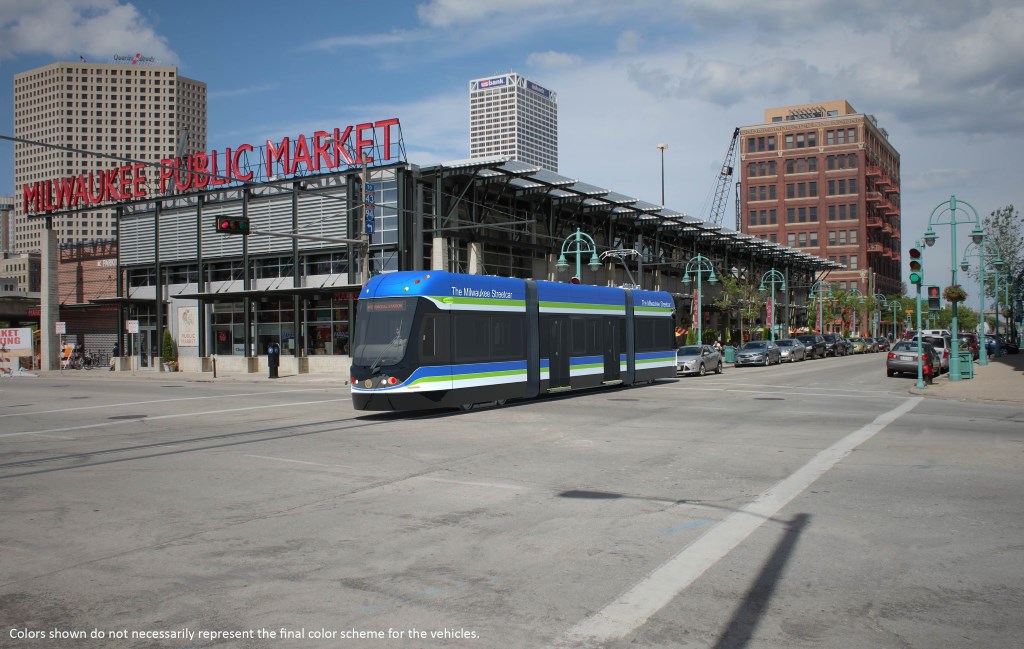First Streetcar Heading to Milwaukee
Left Pennsylvania plant, will arrive by on March 26, mayor announces.

A rendering of a Brookville streetcar in Milwaukee’s Third Ward. Milwaukee’s streetcars will be manufactured by U.S.-based Brookville Equipment Corp.
This is an update on our story from March 16th, “Streetcar Will Run on Streets Next Month.”
Mayor Tom Barrett announced Friday afternoon that the city’s first streetcar vehicle is now headed for Milwaukee. “The vehicle just left the Brookville Equipment Corp. plant in Pennsylvania by truck and will arrive here as early as Monday, March 26,” Barrett said in an email. “It’ll roll off the truck and then head inside our new Operations and Maintenance Facility at 4th and St. Paul. I will be inviting you to a formal unveiling of the first vehicle in a few weeks. You’re also welcome to stop by to see the vehicle arrive, although the exact time and day won’t be known much in advance.”
“You can follow the progress of this first vehicle’s delivery and expected arrival time on the Milwaukee Streetcar social media,” Barrett noted. “We’ll be using the hashtags #THEHOPMKE, #MILWAUKEEORBUST and #BORNTORIDE to help you follow the vehicle’s delivery.”
Original Story
The first of five Milwaukee Streetcar vehicles is scheduled to arrive in Milwaukee on March 26th. And after a few weeks of final assembly and system testing, the Pennsylvania-built vehicle will begin rolling on city streets on April. The announcement comes 60 years to the month after the last streetcar operated on Milwaukee streets.
The initial test section of track will be from the Operations and Maintenance Facility on N. 4th St. underneath Interstate 794 to the station at W. St. Paul Ave. and N. Plankinton Ave. Testing will expand to the entire route from the Milwaukee Intermodal Station to the intersection of N. Prospect Ave. and E. Ogden Ave. in mid-to-late June according to project representative Patrick J. Flaherty.
Department of Public Works Commissioner Ghassan Korban declined to identify the final color scheme of the vehicle, but did say the vehicles will have a drastically different paint scheme than what has previously been depicted in renderings. However, one thing is certain to be highlighted on the vehicles: Potawatomi Hotel and Casino. The city announced a $10 million, 12-year presenting sponsorship arrangement with the casino in October for the $128 million project. The system’s official name will be “The Hop, presented by Potawatomi Hotel and Casino.”
The vehicle, which will be shipped to the city on an oversized truck, will arrive without a few key components installed. The pantograph system, which connects the vehicle to the overhead wire system, will be removed to allow the vehicle to fit under bridges. A “skirt,” which covers the lowest level of the vehicle, will also be missing. Those components will be installed before streetcar operator Transdev begins testing the vehicle.
“It’s going to be somewhat of a teasing phase, where people can see it, but they can’t touch it,” said Korban. Federal guidelines dictate that the vehicle will need to run for 1,000 kilometers before the system can be put into service, or approximately 151 roundtrips on the system’s first phase. “We would love to really invite the public, but we’re systems testing. Just know that we’re making it ready for you to ride,” said streetcar general manager Darryll Simpson.
The city made the vehicle arrival announcement at a regularly scheduled meeting of the Joint Committee on Downtown Streetcar Implementation. Korban said that while the vehicle delivery was originally anticipated to occur a month earlier, it is still within the anticipated delivery window and will not impact the project’s timeline.
The 2.2-mile initial phase is scheduled to begin operation in late 2018, with the extension to the lakefront entering service in 2019.
“To date we are still projecting under budget,” said Flaherty of The Concord Group. The firm, which serves as the city’s owner’s representative on the project, reported that $80.36 million has been spent on the project to date, including $1.13 million from a $4.84 million contingency fund.
Final design work on the lakefront extension is complete and track work on that segment will is scheduled to begin this year. Flaherty said the utility relocation costs are within the projected budget. All utility relocation work is scheduled to be completed by the end of April.
Flaherty reported system construct manager Kiewit Infrastructure is ahead of scheduling on meeting a requirement to hire unemployed or under-employed city residents. Through December approximately 43 percent of the project’s construction hours have been performed by Resident Preference Program participants. Kiewit must meet a city-imposed requirement that 40 percent of the hours be performed by RPP participants. The 40 percent has recently been exceeded by Northwestern Mutual on their new tower and the Milwaukee Bucks are on track to surpass it on the new arena, but smaller developers have struggled to meet the requirement that comes with any project receiving $1 million or more in city funds.
2-Story Hired to Market System
City engineer Jeff Polenske announced the city is negotiating the final details of a contract to market the system with 2-Story Marketing. The Walker’s Point-based firm will be in charge of developing public information and safety campaigns around the system, as well as generating more sponsorship deals. The firm will also be responsible for developing a final website that reflects the new brand, The Hop.
“Obviously 2-Story is incredibly proud to be part of this transformational project,” said firm owner and president Ellen Homb. “Even though we’re small, we’re very mighty in our reach.” Homb said the firm’s client roster includes the Milwaukee Metropolitan Sewerage District, Milwaukee Public Schools and Brewers Community Foundation. The firm has previously worked with the city on the Lead Safe Milwaukee campaign and with the Forestry Department.
The city received six bids from local firms to market the system. Helping the city analyze the bids were private sector partners Tarik Moody of 88Nine, Gary Witt of the Pabst Theater Group, Scott Schwebel of Colectivo Coffee and Megan Suardini of VISIT Milwaukee. “It was really important for us to not only get the experience on the marketing side from some outside individuals, but also a different set of eyes from a business standpoint,” said Polenske.
Koban and Polenske declined to identify the other bidders.
Streetcar Hiring Underway
System general manager Darryll Simpson reports that Transdev has begun hiring for the project. The manager, who works for Transdev North America, said the system is currently looking to hire nine individuals. TransDevNA.com lists four positions in Milwaukee for supervisory and technician roles.
Simpson told the committee: “We’re looking at having a great startup here in Milwaukee. I don’t see any obstacles.”
Hiring for vehicle operators will begin in late April according to Simpson. The jobs will be posted on TransdevNA.com and MilwaukeeStreetcar.com
“We have a very robust training program, for the supervisory staff, operator staffing, maintenance staff. If you come in with the right qualities that we can build out from, that’s what we’re really looking for,” said Simpson.
City Misses on Federal Grant for Arena Extension
The city again failed on a federal grant application to partially support the extension of the system to the new arena. The city had applied for the grant through the Targeted Investment Generating Economic Recovery (TIGER) program. However, the U.S. Department of Transportation under the direction of Secretary Elaine Chao and President Donald Trump has drastically altered the competitively-awarded program to favor rural highways, with only 3.8 percent of the latest grant round supporting transit projects. “Previous rounds of TIGER grants allocated about 15-30 percent of the total to transit, a quarter to walking and biking projects and less than half to roads and bridges,” reports Streetsblog editor Angie Schmitt.
After multiple submissions, the city received a $14 million grant in 2015 to support the lakefront extension. The city also received past TIGER grants for other projects, including the reconstruction of the Juneau Avenue bridge over the Milwaukee River.
The city intends to continue to apply for future TIGER grants.
If you think stories like this are important, become a member of Urban Milwaukee and help support real independent journalism. Plus you get some cool added benefits, all detailed here.
More about the Milwaukee Streetcar
For more project details, including the project timeline, financing, route and possible extensions, see our extensive past coverage.
- Council Kills Streetcar’s ‘Festivals Line’ - Jeramey Jannene - Jul 31st, 2024
- Streetcar Will Use Festivals-Oriented Route Through Summer - Jeramey Jannene - Jul 9th, 2024
- The Hop’s Lines Will Merge For Easier Summerfest Service - Jeramey Jannene - May 30th, 2024
- Streetcar Begins Daily Service To The Couture, BRT Will Soon Follow - Jeramey Jannene - Apr 11th, 2024
- Milwaukee’s Three Streetcar Extensions Need Mayoral Direction - Jeramey Jannene - Nov 8th, 2023
- Transportation: Streetcar Extension Opens Sunday - Jeramey Jannene - Oct 28th, 2023
- Ride Along On Streetcar Extension Before It Opens - Jeramey Jannene - Oct 11th, 2023
- Lakefront Streetcar Extension Opens October 29 - Jeramey Jannene - Aug 22nd, 2023
- Streetcar Ridership Has Climbed For 27 Straight Months Year-Over-Year - Jeramey Jannene - Jul 28th, 2023
- Transportation: Harley-Davidson Is New Streetcar Sponsor - Jeramey Jannene - Jul 7th, 2023
Read more about Milwaukee Streetcar here
Eyes on Milwaukee
-
Church, Cupid Partner On Affordable Housing
 Dec 4th, 2023 by Jeramey Jannene
Dec 4th, 2023 by Jeramey Jannene
-
Downtown Building Sells For Nearly Twice Its Assessed Value
 Nov 12th, 2023 by Jeramey Jannene
Nov 12th, 2023 by Jeramey Jannene
-
Immigration Office Moving To 310W Building
 Oct 25th, 2023 by Jeramey Jannene
Oct 25th, 2023 by Jeramey Jannene
Transportation
-
MCTS Adds 28 New Buses
 Jul 13th, 2024 by Graham Kilmer
Jul 13th, 2024 by Graham Kilmer
-
MCTS Designing New Bus Shelters
 Jul 10th, 2024 by Graham Kilmer
Jul 10th, 2024 by Graham Kilmer
-
MCTS Updates RNC Bus Detours To Better Serve Downtown, Riders
 Jul 9th, 2024 by Jeramey Jannene
Jul 9th, 2024 by Jeramey Jannene






















Best part about all of this:
the project is still way under budget!! Well done MKE!!!!
Congratulations, Milwaukee! You’ve successfully jumped into the bold new era of the early 1900’s.
WCR- As compared to that late 1800’s technology called the ‘horseless carriage’ that our government spends billions maintaining and adding onto each year just here in WI? Still stuck on that 19th century technology I see.
The people said “we don’t want it” but you build it anyway. Waste of money. It’ll be a bum and drunk train in three months.
It’s cheaper than maintaining buses, more reliable, and once it expands, it will be a great mode of transportation. Still, Koch Brothers funded AM radio show hosts and anti mass transit bots keep spouting off nonsense about how this is just a bad idea. The financial numbers don’t lie, this could be a better way to move people around the city. Don’t fall for the junk you hear on AM radio.
Cheaper to lay road than track.
https://www.dot.state.oh.us/Divisions/Finance/GASB%2034%20Documents/PavingCostpermile.pdf
-$100 million dollars to lay 2.5 miles of track versus $100 million dollars gets you 90 miles of two lane road.
Guess what streetcar haters, (of which I consider myself one) the time to present a rational case in opposition to this was never, and it’s more neverer now than ever.
In my view, the smashing success of The Streetcar has been it’s ability to be THE dominant direction of local “statecraft” for in excess of 8 years, despite being at best a gamble not worth taking.
I would be interested to read what other haters have learned from this saga over the years. There’s also no shortage of people who never took The Streetcar seriously until track started showing up.
Troll, actually, track is cheaper than road. While you claim $100 million for 90 miles of rural 2-lane road, just $15 million buys 75 miles of rural track.
http://www.jsonline.com/newswatch/105677678.html
The up-front streetcar cost includes much more than just track. There’s also a fleet of 150-passenger vehicles (and their service/storage facility), at least 17 passenger stations (raised 14 inches), the 750 Volt DC electrical system, upgraded traffic signals, and underground utility relocation.
Once opened, it will be faster (less time spent turning around and at stations) and cheaper to operate than buses on the same route. And it has already attracted private-sector subsidy money, which is something MCTS has never done.
It’s going to be a blast to ride. My kids will love it. Naysayers can pout and ride their tricycles.
Of course, if you are against the streetcar project you would not want to mention how successful streetcars have been in Atlanta, The Twin Cities, Portland OR, and elsewhere. Public transportation is the way of the future. Roads are much more expensive to build and maintain; plus freeways take land off the tax roll while public transportation has shown to generate enormous amounts of investment that add to the tax roll. Again, I would direct you to the success of our western neighbor.
Looking forward to riding The Hop around town. I will probably hopscotch from coffee shop to coffee shop and take in the city without having to drive. Thanks for sticking with this project.
mkwagner, it’s not just the acres occupied by freeways, it’s also how the nearby land (outside the freeway right-of-way) gets damaged. Look at what gets built next to freeways—mostly low-value projects like big-box stores and strip malls. Then look at passenger rail in other cities where land near train stations is used for more valuable things like office buildings or apartment/condo projects.
While you sometimes see office parks near freeways, you never see the actual buildings next to the highway; they always use parking lots to buffer the noise and pollution. But when offices (or apartments/condos) go up near rail, they often go right next to the tracks. This shows that passenger tracks don’t damage adjoining land like highways do.
It’s interesting to note that Milwaukee’s population decline (from 741,324 in the 1960 census) started just as freeways were introduced.
Potawatomi money is temporarily. The city of Milwaukee needs a transportation tax to make this work. The experience will be surreal for your family. You will get to meet Chief, Breadman and many other local homeless riders.
I have to say I’m always impressed by the intelligence, insight, and perspectives of the commenters on this and other UM threads. I learn a lot from you all.
And then there’s Troll.
Troll, the City will not need a transportation tax. They won’t even need property tax dollars. They will use parking revenue. Today, the City collects about $40 million from parking (meter fees, parking fines, and garage leases) and spend about $20 million collecting that money (meter enforcement, bond payments on parking garages, etc) which leaves them with a $20 million surplus (which is used to hold down property taxes).
The plan is to increase that $40 million revenue by about 5% (through a combination of increased parking activity—due to all the new downtown buildings—and, if needed, through slightly higher rates.) That increased revenue will fund the streetcar operations after the casino and federal money run out.
Downtown has seen a boom in private real estate development since the streetcar was approved in 2011. (Similar booms have accompanied downtown streetcar introductions in Portland, Seattle, Tucson, Kansas City, Cincinnati, and Washington DC. Portland has even demonstrated that development dollars were directly related to the streetcar—concentrated within a block or two of the tracks.) While some of this construction (like the new Bucks arena) would have happened without the streetcar, much of it was triggered by the streetcar approval.
This new development means increased property tax revenue—much more revenue than what the City will spend to subsidize the streetcar operation. In 2011, the City said that property taxes on $205 million in new property value would more than cover the annual streetcar operating subsidy. Since then there has been much more than $205 million in new construction downtown.
Transit Rider, I disagree. The boom to downtown since 2011 is purely a millennial desire. Corporations are chasing workers and this and not the trolley is the catalyst. When millennial decide to procreate there is no option for education in milwaukee. Unless we go with the Peter Pan theory and presume they stay in their present state.
Crazy Chester, are you suggesting the homeless have no legal right to ride the Hop. Last I looked its free. Who will decide in your stop and frisk world who gets the right to hop? Will the Hop be a safe zone. How will it enforce civility and if it is a gun free zone who will stop and frisk?
Troll, while I don’t agree with your characterization of the boom as being millennial-fueled, the cause doesn’t matter. Even if millennials eventually move en masse to the suburbs as they age, their places will be taken by younger Americans. And even if, after millennials moved out, the next generation didn’t want to live downtown, that wouldn’t even matter (much) either, since the city is taxing buildings (which cannot move out of town).
Two reasons why I don’t buy your “It’s all the millennials” claim:
• How do you explain that this happens in city-after-city, in different years (e.g. starting in 1997 in Portland, but 2011 in Milwaukee)? I think it’s because Portland finalized its streetcar plans in 1997 (opened in 2001) and Milwaukee approved the Hop in 2011.
• I think baby-boomers are potentially a big part of the back-to-downtown movement. As you get older, driving gets harder; your reaction time and eyes get worse (especially at night). Many seniors get neuropathy, a progressive disorder where you slowly lose feeling in your feet. (Imagine driving if you couldn’t always feel the difference between the brake and accelerator pedals! This is how seniors sometimes lose control and rear-end cars at traffic lights—or worse, plow into pedestrians!)
As baby boomers retire (meaning they no longer drive to work) they often decide they want to live somewhere where most daily errands can be done on foot.
No Troll, I’m suggesting – no, stating – that your comments are consistently incoherent and often tangential. The conclusion you drew from my comment was utterly irrational. I guess that’s just you living up to your name, though.
I am interested in seeing how the Hop reshapes life in the city for people. As it grows, moving further north and south, it will give all new access to life in the city and sprout new development. I look forward especially to seeing what it will do eventually along King Drive. Who wouldn’t love to see that thoroughfare really come to life?
I I hereby nominate one of the streetcar routes to be named the Bob Donovan ” Route to Nowhere ” . May he be proud.
-Zielinski gets a leg also designated ” The Twilight Zone “
Troll speaks right-wing gibberish that rarely makes sense. He doesn’t even try. I mean he’s a troll after all.
The takeaways from this experience for me have been many.
A large one was the “unknown known” that “there is no money in no money”. Lots of money was, is, will have been, and will continue to be spent on this project for years before, and after a streetcar is available to passengers. Nobody paid anybody, anywhere to show up at meetings, produce artistic renderings, or prepare financing arrangements – to oppose this project, despite the volume of folks who felt it goofy for many years now.
Any time spent in the early days of this project waiting for more reasonable, educated consideration was captured by proponents making this thing harder to back away from.
The good news is that there have been enough lame projects Nationwide that people are starting to share notes, the bad news might be that the fewer places amenable to such things will probably get pushed harder- we seem to be part of the latter group at this point.
I think this is good news. Aside from allowing Milwaukee to better compete with other cities, It is evidence that, despite the best efforts of the naysayers, they can be beaten.
Excited to see this implemented and looking forward to the route expandiimg.
Whatever aside -the first introduction of streetcars after a many years absence has been a somewhat dangerous time anywhere as there’s always some folks who don’t really pay attention to a new thing on the street. New parking policies on the route, and keeping bicyclists from hurting themselves on tracks have been a particular problem in other areas. Don’t let expectations of hater schadenfreude slow down any efforts to make this safe.
I look forward to the extension to North Ave to tap into the population along Prospect Avenue and Farwell Street and the large population on the upper east side north of North Ave. The Hop would be a great way to get downtown without having to take out the car.
I am proud of our city leaders who fought for the streetcar despite right wing rhetoric on the radio and media. I hope the streetcars have a very colorful paint scheme that stands out. Milwaukee needs some flash and what better way to show that flash off by displaying it on the cars. I cannot wait for service to begin and hope for future extensions especially to the UWM area and to the northwest side of the city.